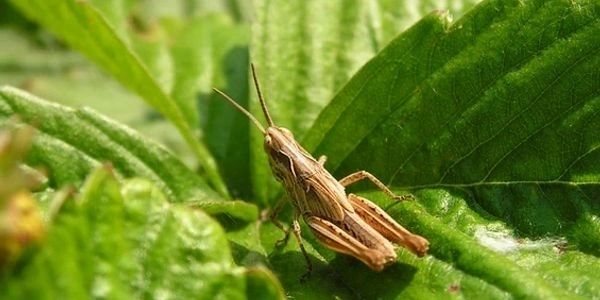
Insects
APHIDS
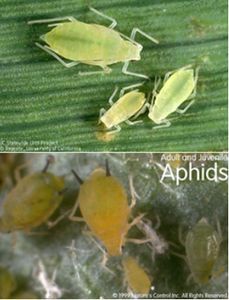
Aphids breed like crazy. One aphid can produce over 70 offspring within a week. They can destroy a plant before you even notice a problem. They need to be treated quickly. They can be treated with a general insecticide. Another option for treatment is to spray the plant down with a strong surge of water. Once aphids are detached from a stem or leaf, they have a difficult time getting reattached. Blast the host plant 2 or 3 times within a few days.
ARMY WORMS

Armyworms are the larvae of moths. They are 1-1/2 inches long; they are greenish and have blackish stripes along each side and down the center of the back. The adults are brownish gray. Their wings measure about 1-1/2 inches across when expanded. The armyworm and the fall armyworm are common species. When they are numerous, they may devour the grass down to the ground. Their feeding causes circular bare areas in lawns.
BAGWORMS
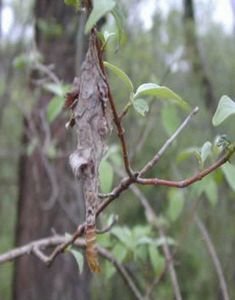
Full-grown larvae are 3/4 to one inch long, dark brown with white to yellowish heads and a black spotted mid-section. Bagworms overwinter as eggs inside the bags of mated females. The eggs hatch in late spring (May to early June) and the larvae begin feeding and constructing their protective case. As the caterpillars grow in size, the bag is constantly enlarged. Male larvae pupate in late summer and they emerge from their bags as black moths with furry bodies, feathered antennae, and clear wings with a wing span of almost one inch. The female is a wingless moth that remains in a worm-like form and never leaves the bag. She is fertilized by the male, lays 500 to 1,000 eggs inside the bag, and then dies. There is one generation per year. Bagworms will attack and defoliate most evergreen and deciduous trees and shrubs, but prefer arborvitae, red cedar, juniper, bald cypress, several species of pine, and boxelder. Bagworms live inside a spindle-shaped bag which they construct while they are in the larval or caterpillar stage. The bags are dragged with the caterpillars wherever they go and are made of silk and bits of foliage.
CHINCH BUGS
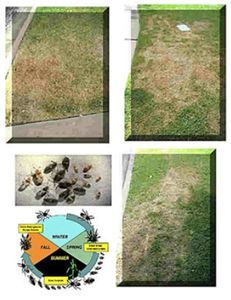
Chinch bug damage can be confused with certain lawn diseases or other physiological disorders. Brown patch is a common disease affecting the leaf blades of St. Augustine grass. Brown patch symptoms, however, usually occur in a circular or semi-circular pattern, as opposed to the irregular-shaped areas of dead and dying grass that result from chinch bug feeding. Chinch bug damage also can be difficult to distinguish from that caused by drought. Detection of significant numbers of the insects themselves is the best proof that chinch bugs are the cause of the damage. When chinch bugs damage St. Augustine grass, the only choices are to treat with insecticides or to watch the lawn die. When chinch bugs damage St. Augustine grass, the only choices are to treat with insecticides or to watch the lawn die. When chinch bugs damage St. Augustine grass, the only choices are to treat with insecticides or to watch the lawn die.
CUTWORMS
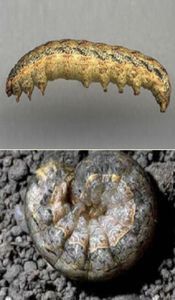
Cutworms attack many vegetable crops, grasses, and field crops such as cotton, corn, and peanuts. The hairless, caterpillar larvae of various night-flying moths, in various colors from black, gray to brown, about 1 and 1/2 inches at maturity, curl up tightly in a spiral shape when disturbed. Black cutworm larvae are dark gray to black, with a pale yellow line down the center of the back and three yellow lines along each side although these yellow lines are not distinct in some. Granulate cutworm larvae are dusty brown with rough granulated skin. Variegated cutworm larvae have a distinct, pale yellow dot on the mid-dorsal line of at least the first four abdominal segments. Cutworms attack all common turfgrass, and seedlings or recently transplanted garden vegetables or flowers, severing stems. This early season pest is usually of greatest concern during early development of field crops, typically within 10 to 14 days of crop emergence. Young larvae (up to 1 /2 inch long) feed above ground on various weeds and crops, particularly corn. When larger, they frequently feed at or just below the ground surface, and are more commonly found below ground, when the soil surface is dry and crusted, cutting plants off near ground level. In lawns, they wreck havoc during spring and summer, causing small patches of sod to turn brown and die. Grass blades around the margins of the affected areas show jagged holes along their edges, making the entire lawn look ragged. They feed only at night, spending days hidden in debris or in the thatch near the surface of the soil.
GRUBS
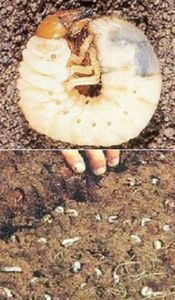
Larvae (of Adult May or June beetles) are white, C-shaped grubs with distinct, brown heads and three pairs of legs near the front end. Larvae or grubs about 1 to 1.5 inches long when fully grown, C-shaped when at rest with many folds or wrinkles in the front half of body. Read the end of the body often slightly larger in diameter than rest and may be bluish or blackish in color. (Grubs of the pillbug or weevils are legless) Larvae feed on the dead organic matter and on the roots of most grasses, causing browning and dying of the grass in localized spots or in large irregular-shaped areas. Where infestations are heavy, the grassroots may be entirely eaten away and the turf may be rolled back like a carpet. Damage may be severe in September and October when the grubs are reaching maturity, and the growth of bermudagrass is slowing down.
MITES
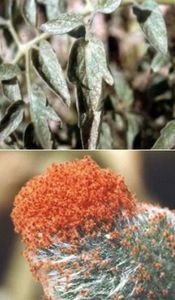
most spider mites and during the summer months, they can complete a generation in 7 to 14 days. Besides red, the mites may be yellow or green with two dark spots on their bodies. They are about 1/50-inch in length. Probably the most common mite problem is due to the two-spotted mite. Two-spotted mites cause chlorotic stippling of leaves giving the appearance that a fine tan to yellow sand has been sprinkled on the foliage. As populations increase, webbing is often spun over foliage and flowers. These mites are most likely to be found on the underside of leaves and in the flowers. The mites’ piercing-sucking mouthparts cause curling of leaflets from outside inward by creating small depressions in young leaves. Damaged flower buds sometimes will not open or open only to be distorted. They spin tiny webs between the leaves and stems of a plant and suck juices from leaves, stems, and buds. Symptoms of injury include flecking, discoloration (bronzing) and scorching of leaves. Injury can lead to leaf loss and plant death. On tomatoes, greasy yellow to bronze-colored leaves are a sure sign of the tomato russet mite. Early detection is important. The mites can be detected by placing a piece of paper underneath the plant and shaking the plant over the paper. The mites can then be seen on the paper.
MOLE CRICKET AND MOUNDS
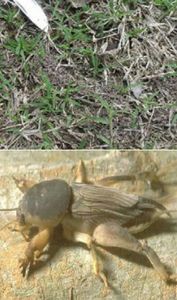
Warm-season lawn, particularly those with heavy thatch. Cricket-like in shape but has mole-like, digging front legs. Two Oklahoma species, Northern mole cricket and Prairie mole cricket, are found mostly in the eastern 2/3 of the state. They spend most of the year burrowing just below the surface of the soil and are active above ground in April and May in Oklahoma for mating and dispersal flights. Mole crickets use huge claws on their forelegs to dig through the lawn and soil surface, uprooting large patches of grass. They feed on plant roots, insects, and decaying organic matter.
SCALE
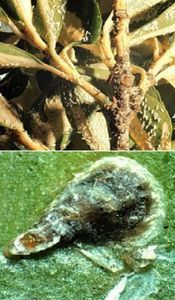
This scale attacks many species and varieties of plants, including euonymus, camellia, celastrus, ivy, hibiscus, holly, and ligustrum. The female scales are brown or dark brown, pear-shaped, and slightly over 1/16th inch long. The exuviae (first molted skin) is at the narrow end. Male scales are elongate, tiny, and chalky white in color with the exuviae at one end. As usual with armored scales, the actual body of the female is yellowish and sac-like with well-developed mouthparts but without legs, eyes, or antennae. The adult male is a small, gnat-like insect. Scale is often overlooked until it has caused serious damage. One symptom of a light attack is the occurrence of yellowish or whitish spots on the leaves. The female scales are usually found along the stems and leaf veins of the host plant. At times, however, the whole plant is “whitened” by the covers of the smaller male scales. When this occurs, the plants’ leaves may drop and sometimes a normally green plant becomes bare by midsummer. Heavily infested plants are usually killed if not treated. Plants growing close to buildings seem to be damaged more than those growing where there is free air circulation.
WHITE FLIES
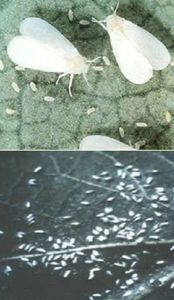
Whiteflies are not true flies. They’re more closely related to scales, mealybugs, and aphids. These pests are more commonly associated with plants growing in greenhouses than those growing in homes. Adult whiteflies are small insects, approximately 1/16th inch (1.5 mm) in length, with four powdery white wings. When heavily infested plants are disturbed, one may notice a “cloud” of tiny white insects rising above it. The immature stages (eggs, crawlers, scales, and pupae) are all yellowish and found primarily on the undersides of leaves.All stages of whiteflies feed on plant sap, using their piercing-sucking mouthparts. Infested leaves can yellow and drop, reducing plant vigor, but usually not killing the plant.
